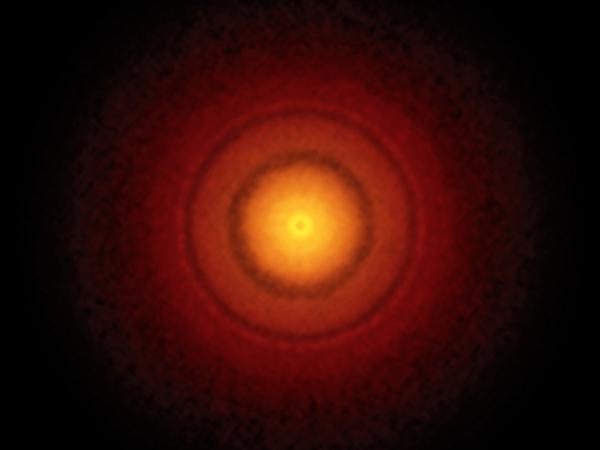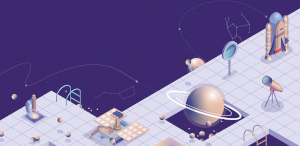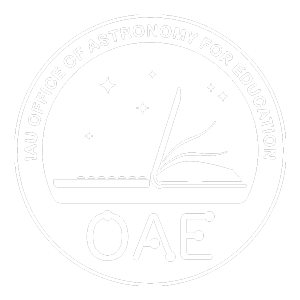This page describes an image Planet formation around the star TW Hydrae
Image caption:
This image shows the disk around the young star TW Hydrae. This star is only about 10 million years old, young enough that planets are still forming in a disk of gas and dust around it. This image was created using an array of submillimetre telescopes, each of which looks like a satellite dish. The signals from these telescopes were combined by a central processing computer to make this image. The lighter and darker patches show areas of the disk where there is more or less dust respectively. The dark rings and bright rings are evidence that the dust in the disk has been shepherded into some orbits and away from others. This is likely because there is one or more planets that are still forming hidden in the disk.
The whole image shows the disk around TW Hydrae out to a distance of about 70 astronomical units frm the central star. The two outer dark rings are separated from the central star by approximately the average distance between the Sun and Uranus and the average distance between the Sun and Pluto. The inner central hole appears to have been carved out by a planet orbiting TW Hydrae at a distance similar to the distance between the Earth and the Sun.
Scroll to captions in other languages
Image credit:
S. Andrews (Harvard-Smithsonian CfA); B. Saxton (NRAO/AUI/NSF); ALMA (ESO/NAOJ/NRAO) Credit Link
Related glossary terms:
Planet Formation
Categories:
Exoplanets & Astrobiology
Image license: Creative Commons Attribution 4.0 International (CC BY 4.0) Creative Commons Attribution 4.0 International (CC BY 4.0) icons
The media file captions presented on the OAE website were written, translated and reviewed by a collective effort from the OAE, the OAE Centers and Nodes, the OAE National Astronomy Education Coordinators (NAECs) and other volunteers. You can find a full list of credits for our translation project here. All media file captions are released under a Creative Commons CC BY-4.0 license and should be credited to "IAU OAE". The media files themselves may have different licenses (see above) and should be credited as listed above under "credit".
If you notice a factual error in this caption or an error in any of its translations then please get in touch.
Captions in Different Languages:
Image caption: Questa immagine mostra il disco attorno alla giovane stella TW Hydrae. Questa stella ha solo circa 10 milioni di anni, abbastanza giovane da essere ancora circondata da un disco di gas e polvere in cui si stanno formando dei pianeti. Questa immagine è stata creata utilizzando una schiera di telescopi submillimetrici, ognuno dei quali assomiglia a un'antenna parabolica. I segnali provenienti da questi telescopi sono stati combinati da un computer centrale per ottenere questa immagine. Le macchie più chiare e più scure indicano le aree del disco in cui c'è rispettivamente più o meno polvere. Gli anelli scuri e gli anelli luminosi sono la prova che la polvere nel disco è stata concentrata verso alcune orbite e allontanata da altre. È probabile che questo avvenga perché nel disco sono nascosti uno o più pianeti che si stanno ancora formando.
L'intera immagine mostra il disco intorno a TW Hydrae fino a una distanza di circa 70 unità astronomiche dalla stella centrale. I due anelli scuri esterni sono separati dalla stella centrale da una distanza pari alla distanza media tra il Sole e Urano e alla distanza media tra il Sole e Plutone. Il foro centrale interno sembra essere stato scavato da un pianeta in orbita attorno a TW Hydrae a una distanza simile a quella tra la Terra e il Sole.
Image credit: S. Andrews (Harvard-Smithsonian CfA); B. Saxton (NRAO/AUI/NSF); ALMA (ESO/NAOJ/NRAO)
Related glossary terms: Formazione dei pianeti Caption translation status: Approved by a reviewer
Caption translators: Giuliana Giobbi, Valentina La Parola
Caption reviewers: Silvia Casu, Rodolfo Canestrari
Image caption: 这幅图像显示的是年轻恒星长蛇座TW周围的物质盘。这颗恒星足够年轻,的年龄只有大约一千万年,因此其周围的气体和尘埃盘中仍在形成行星。这幅图像是利用亚毫米望远镜阵列制作的,其中每台望远镜看起来都像一个碟形天线。这些望远镜接收到的信号由一台中央处理计算机合成,从而生成了这幅图像。其明暗程度表示的是物质盘上尘埃的多少。图中的暗环和亮环表明物质盘中的尘埃被带入了某些轨道,并远离了其他轨道。这可能是因为物质盘中隐藏着一颗或多颗仍处在形成过程中的行星。
整幅图像显示的环绕长蛇座TW的物质盘延伸到了距离中心恒星约70个天文单位处。外侧的两个暗环与中心恒星的距离大致相当于太阳与天王星之间的平均距离以及太阳与冥王星之间的平均距离。内侧中央的洞似乎是由一颗环绕长蛇座TW运行的行星雕刻出的,其与中心恒星的距离大致相当于地球与太阳之间的距离。
Image credit: S. Andrews (Harvard-Smithsonian CfA); B. Saxton (NRAO/AUI/NSF); ALMA (ESO/NAOJ/NRAO)
Related glossary terms: 行星形成 Caption translation status: Not yet approved by a reviewer
Caption translators: Bao Lizhuo
Image caption: 這幅圖像顯示的是年輕恆星長蛇座TW周圍的物質盤。這顆恆星足夠年輕,的年齡只有大約一千萬年,因此其周圍的氣體和塵埃盤中仍在形成行星。這幅圖像是利用亞毫米望遠鏡陣列製作的,其中每臺望遠鏡看起來都像一個碟形天線。這些望遠鏡接收到的信號由一臺中央處理計算機合成,從而生成了這幅圖像。其明暗程度表示的是物質盤上塵埃的多少。圖中的暗環和亮環表明物質盤中的塵埃被帶入了某些軌道,並遠離了其他軌道。這可能是因為物質盤中隱藏著一顆或多顆仍處在形成過程中的行星。
整幅圖像顯示的環繞長蛇座TW的物質盤延伸到了距離中心恆星約70個天文單位處。外側的兩個暗環與中心恆星的距離大致相當於太陽與天王星之間的平均距離以及太陽與冥王星之間的平均距離。內側中央的洞似乎是由一顆環繞長蛇座TW運行的行星雕刻出的,其與中心恆星的距離大致相當於地球與太陽之間的距離。
Image credit: S. Andrews (Harvard-Smithsonian CfA); B. Saxton (NRAO/AUI/NSF); ALMA (ESO/NAOJ/NRAO)
Related glossary terms: 行星形成 Caption translation status: Not yet approved by a reviewer
Caption translators: An automated transliteration from the simplified Chinese translation by - Bao Lizhuo









